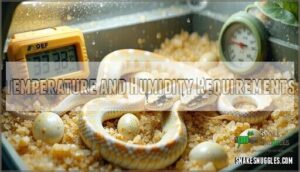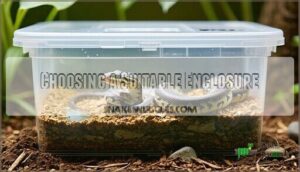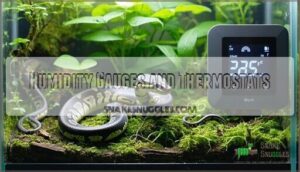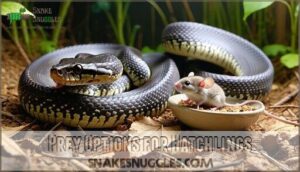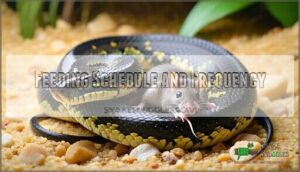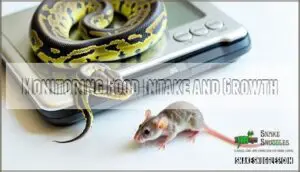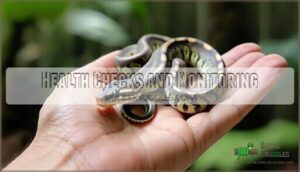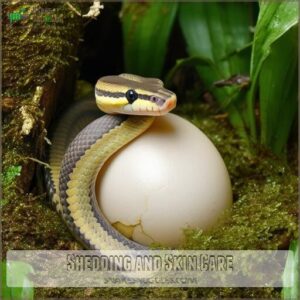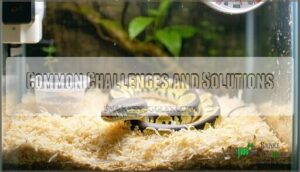This site is supported by our readers. We may earn a commission, at no cost to you, if you purchase through links.
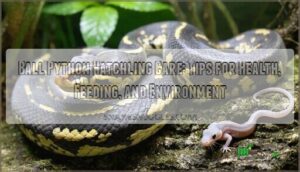
Keep the temperature between 75-80°F on the cool side and 88-92°F on the warm side, using a thermostat to maintain these levels.
Humidity should stay at 50-60%, bumping to around 70% during shedding.
Feed appropriately sized prey weekly – usually thawed pinky mice – and monitor their weight and appetite.
Handle them gently, limiting stress by giving them time to adjust to their new home, and with the right setup and care, your hatchling will grow healthy and strong.
Curious about shedding cycles?
Table Of Contents
- Key Takeaways
- Ball Python Hatchling Environment
- Temperature and Humidity Requirements
- Essential Supplies for Hatchlings
- Feeding Hatchling Ball Pythons
- Handling and Socialization Techniques
- Health Checks and Monitoring
- Shedding and Skin Care
- Growth and Development Stages
- Common Challenges and Solutions
- Long-Term Care and Planning
- Frequently Asked Questions (FAQs)
- What to feed a newly hatched ball python?
- How to care for a hatchling snake?
- How often should a hatchling ball python eat?
- Can you leave a heat lamp on 24/7 for ball python?
- How long does it take a ball python to hatch?
- Do ball pythons need humidity?
- How to set up a ball python’s habitat?
- What temperature do ball pythons require?
- How to care for a ball python hatchling?
- What to feed a ball python hatchling?
- Conclusion
Key Takeaways
- Maintain proper temperatures with an 89-92°F basking spot, 75-80°F cool side, and stable 50-60% humidity to ensure your hatchling’s health.
- Feed thawed pinky or fuzzy rats weekly, making sure prey is no larger than your snake’s thickest part, and track its growth regularly.
- Provide a secure 10-gallon enclosure with multiple hides, cypress mulch substrate, and soft lighting to create a safe, stress-free environment.
- Handle gently with short, calm sessions and watch for stress signals like rapid breathing or hiding to build trust and avoid health issues.
Ball Python Hatchling Environment
Creating the right environment for your ball python hatchling is key to keeping it healthy and stress-free.
Creating a safe, cozy environment is the foundation for a healthy, thriving ball python hatchling.
Start with a secure enclosure, like a 10-gallon tank.
A small space creates a sense of safety.
Proper ventilation guarantees fresh airflow, preventing any buildup of humidity or odor.
When planning lighting needs, opt for soft lighting to mimic natural daylight without stressing your snake.
Remember, hiding spots are essential.
These give your python a safe retreat, helping reduce stress and mimic its natural burrowing behavior.
Quality substrates also support burrowing.
This python hatchling setup should feel cozy but functional, with the right balance of enclosure security, substrate options, and adequate ventilation.
Meeting these basics is the foundation for regulating python humidity temperature and supporting a healthy, thriving snake.
Temperature and Humidity Requirements
Keeping the right temperature and humidity is essential for your ball python hatchling’s health and comfort. By maintaining proper levels, you can help prevent stress, shedding problems, and respiratory issues.
Maintaining optimal temperature and humidity ensures your ball python hatchling stays healthy, stress-free, and thrives in its perfect environment.
Ideal Temperature Range for Hatchlings
A ball python hatchling’s health depends on maintaining the ideal temperature range. Proper heating guarantees comfort and activity.
- Basking Spot: Keep it at 89-92°F for warmth.
- Cool Zone: Maintain cooler areas at 78-80°F.
- Night Temps: Small drops are fine but avoid extremes.
- Thermostat Choice: Use reliable tools for monitoring heat sources and achieving precise temperature control.
Maintaining proper humidity, which impacts shedding, requires accurate humidity monitoring.
Maintaining Optimal Humidity Levels
Consistently maintaining ideal humidity levels between 50-60% is essential for your ball python hatchling’s health.
Use cypress mulch substrate to retain moisture and prevent respiratory infections. Monitor humidity daily with a reliable gauge.
Mist occasionally when levels drop, but avoid sogginess. Place a humid hide filled with damp sphagnum moss on the warm side to assist with shedding.
You can purchase cypress mulch from various online retailers. Proper humidity management helps prevent common health issues like stuck sheds.
Setting Up a Temperature Gradient
Now that you’ve mastered humidity control, let’s set up a proper temperature gradient for your hatchling.
Place heat sources on one side of the enclosure to create distinct zones: a basking spot temp of 89-92°F and a cool side temp of 75-80°F.
Careful thermostat placement guarantees safety, while regular gradient monitoring prevents dangerous temperature swings.
Consider thermostat product options for accurate temperature control. Your choice of heat source—whether heat tape, mats, or lamps—should match your setup’s specific needs.
Essential Supplies for Hatchlings
You’ll need specific equipment to keep your ball python hatchling healthy and thriving. The right enclosure, heating elements, and monitoring tools form the foundation of proper care.
Choosing a Suitable Enclosure
Selecting the right enclosure forms the foundation of proper ball python hatchling care. For young snakes, start with a small enclosure (10-20 gallon) as oversized spaces can cause stress.
Choose appropriate substrate options like cypress mulch or paper towels that maintain humidity without harboring bacteria. Guarantee adequate ventilation to prevent respiratory issues while maintaining security—young pythons are escape artists!
Place multiple hiding spots on both warm and cool sides of the enclosure to provide security. Plastic tubs with secure lids work well for beginners, offering both affordability and the proper environment your hatchling needs to thrive.
Many keepers utilize a specialized snake enclosure for young ball pythons.
Heating and Lighting Options
Creating the perfect heating system for your hatchling requires careful equipment selection.
Here are five essential heating and lighting options:
- Heat mats provide gentle belly heat when installed under the enclosure
- Ceramic heat emitters offer invisible warmth without disturbing sleep cycles
- Low-wattage basking bulbs create daytime hot spots
- Heat tape systems work well for rack setups
- UVB lighting supports natural behavior patterns
Always connect heating elements to a thermostat to prevent burns.
Humidity Gauges and Thermostats
Moving from heating options, your next essential tools are accurate monitoring devices.
You’ll need reliable humidity gauges and thermostats to maintain your ball python’s health.
Digital hygrometers offer better gauge accuracy than analog models when tracking humidity levels (50-60% ideal).
Place these devices at snake level for true readings.
Smart thermostats prevent dangerous temperature fluctuations by maintaining the perfect range (82-85°F ambient, 89-92°F basking spot).
Consider backup systems for power outages.
Regular thermostat calibration guarantees your readings stay accurate, preventing respiratory infections and shedding problems.
Feeding Hatchling Ball Pythons
You’ll need to feed your ball python hatchling every 5-7 days with appropriately sized prey that’s no larger than the thickest part of its body.
Frozen-thawed rat pups or mouse fuzzies work best for new hatchlings.
Feeding during nighttime hours (9-10 pm) often improves success rates.
Prey Options for Hatchlings
Now that you’ve gathered your supplies, let’s focus on what your baby python will eat.
Hatchlings need appropriately-sized prey that’s 10-15% of their body weight. Start with pinkies or fuzzies, with rats offering better nutritional value than mice.
Frozen-thawed mice are safer than live feeding, which carries injury risks. If your snake refuses food, try scenting techniques.
Never offer prey larger than the widest part of your snake’s mid-section. To guarantee proper digestion, remember to maintain optimal enclosure temperatures and ensure proper care for your pet.
Feeding Schedule and Frequency
A consistent feeding schedule is vital for ball python hatchlings.
Feed your young snake every 5-7 days to support their rapid growth and metabolism.
- Choose prey sized according to your snake’s widest body point (about 1-1.5 times the diameter)
- Offer frozen-thawed mice or rat pups for superior nutrition
- Maintain feeding intervals at nighttime when hatchlings are naturally active
Monitor acceptance carefully—occasional refusal is normal, but persistent issues might indicate environmental stress or health concerns.
Adjusting intervals based on growth guarantees proper nutritional needs are met.
Monitoring Food Intake and Growth
Your hatchling’s growth record helps confirm proper development. Regular weight checks with a gram scale reveal vital health patterns.
| Growth Stage | Weight Range | Prey Size |
|---|---|---|
| Newborn | 50-80g | Pinky/Fuzzy |
| 3 Months | 120-200g | Hopper/Small |
| 6 Months | 300-500g | Adult mice |
Track feeding responses after each meal and note any changes in appetite. Weigh your ball python hatchling weekly at first, then monthly as it stabilizes. Adjust prey size as your python grows – never exceed 1.5 times the snake’s widest point.
Weight tracking helps identify health concerns before they become serious problems, ensuring you can take action to support your hatchling’s overall well-being.
Handling and Socialization Techniques
You’ll need to handle your ball python hatchling gently and limit sessions to build trust while reducing stress.
Regular, brief interactions with your snake will help it become comfortable with you and its new environment.
Safe Handling Practices for Hatchlings
When handling your ball python hatchling, always use gentle, slow movements to reduce stress.
Start with brief 5-minute sessions twice weekly, gradually increasing as your snake builds trust. Always support its body fully, avoiding the head area.
Wash hands before and after handling to prevent disease transmission. Never handle during shedding or within 48 hours after feeding to prevent regurgitation.
Watch for stress signals like rapid breathing or defensive postures. Creating positive experiences now establishes a foundation for a trusting relationship throughout your snake’s life, and helps to reduce overall stress.
Gradual Socialization Methods
Your baby ball python needs time to build trust through gradual socialization. Begin with calm, short handling sessions of 5-10 minutes, twice weekly.
- Keep interactions brief during the first month to reduce stress
- Create positive experiences by handling before feeding day, never after
- Watch for relaxed body language as a sign of growing comfort
Consistent, gentle exposure helps your hatchling adjust to human interaction while establishing trust.
Avoiding Stress and Trauma
To minimize stress and trauma, give your ball python a one-week adjustment period before handling.
Start with brief 5-minute sessions, then gradually increase duration as your snake shows comfort.
| Stress Sign | Cause | Solution |
|---|---|---|
| Hiding constantly | Excessive handling | Reduce frequency |
| Defensive posture | Enclosure insecurity | Add more hides |
| Refusal to eat | Environmental changes | Maintain stability |
| Rapid breathing | Fear response | Handle during evening |
Health Checks and Monitoring
You’ll need to check your ball python hatchling regularly for signs of illness such as respiratory issues, stuck shed, or weight loss.
Regular monitoring helps you catch health problems early and guarantees your snake grows into a healthy adult, with regular monitoring being key to its development.
Common Health Issues in Hatchlings
In your hatchling ball python’s early months, watch for these common health issues:
- Respiratory infections: Listen for wheezing or see mucus around the nostrils
- Shedding problems: Retained skin can lead to infections
- Parasites: May cause weight loss despite regular feeding
- Obesity: Overfeeding leads to harmful fat accumulation
- Anorexia: Extended food refusal requires immediate attention
Regular health checks help catch problems early, preventing serious complications requiring veterinary intervention, which can be critical for the health of your pet.
Recognizing Signs of Illness or Stress
While caring for ball python hatchlings, your ability to spot health issues early can save lives.
Watch for lethargy and apathy – healthy snakes are curious and responsive.
Respiratory distress appears as wheezing, bubbling around nostrils, or open-mouth breathing.
Abnormal shedding, regurgitation signs, and scale abnormalities all indicate problems.
Environmental stressors like incorrect temperatures or handling too frequently can trigger illness.
Regular monitoring helps reduce stress and catches hatchling health problems before they become serious, which is crucial for preventing respiratory distress and ensuring the snakes remain healthy snakes.
Regular Check-Ups and Veterinary Care
While monitoring for stress signs, don’t overlook the importance of professional health checks.
Find a reptile vet familiar with snake health checks before your hatchling needs one.
Regular visits help catch respiratory issues, scale rot, and parasites early.
A good vet can guide you on prolapse treatment and other hatchling health problems.
Schedule check-ups twice yearly, even when your python appears healthy.
Shedding and Skin Care
You’ll need to watch for signs that your ball python hatchling is ready to shed, such as dull skin or cloudy eyes.
Proper humidity levels and a moist hide will help your snake shed its skin in one complete piece, preventing health issues that can occur from stuck shed, which is a critical aspect of maintaining your snake’s overall well-being.
Understanding Shedding Cycles
After monitoring your hatchling’s health, you’ll need to understand their shedding cycles – a normal growth process that happens regularly.
Your ball python’s skin will show clear signs when a shed is approaching:
- The skin loses its shine and becomes dull or grayish
- Eyes turn bluish or milky (called "blue phase" or "in blue")
- The snake may hide more and show less interest in food
Shedding frequency for hatchlings typically occurs every 4-6 weeks, though this varies based on growth rate. Watch for retained eyecaps or incomplete sheds, which signal humidity problems. If your snake shows shedding behavior like rubbing against objects, it’s attempting to remove old skin naturally.
Providing a Humid Environment
Humidity creates the foundation for successful shedding.
Maintain levels between 50-60% to prevent shedding problems and support respiratory health.
Use cypress mulch as your substrate choice, which naturally retains moisture.
Place a humid hide containing damp sphagnum moss on the warm side of the enclosure.
Install reliable humidity gauges and thermostats for accurate monitoring.
Mist lightly when needed, but make certain proper ventilation to prevent mold growth.
Your python’s skin health depends on this careful balance of maintaining the right environment, including the use of a humid hide with damp sphagnum moss.
Assisting With Problem Sheds
Problem sheds in ball python hatchlings typically stem from inadequate humidity.
When your snake struggles to shed, increase humidity levels to 80%+ during the shedding process.
Create a humidity hide with damp paper towels or sphagnum moss.
For stubborn stuck shed, soak your hatchling in warm water for 20 minutes, then gently rub remaining pieces with a damp cloth.
Repeat daily if needed, but avoid rushing the process.
Growth and Development Stages
You’ll notice your ball python hatchling grows from a tiny 60-gram snake to nearly 700 grams within its first year.
Understanding these growth patterns helps you provide the right care as your snake passes through different developmental stages.
Monitoring Growth Rates
During the first year, track your ball python’s weight weekly using a digital scale.
Record measurements alongside shed frequency in a growth chart. A healthy hatchling should steadily gain 50-100 grams monthly when fed appropriately-sized prey.
Body condition scoring helps identify growth abnormalities early—look for a rounded triangle shape when viewed from above.
Size progression slows after year one, so don’t worry if weight gain becomes less dramatic, as this is a normal part of their development, related to their body condition.
Developmental Milestones
While tracking growth rates helps you measure progress, understanding developmental milestones shows your ball python’s journey to maturity.
Hatchlings typically have their first shed within 7-14 days after hatching. Watch for consistent feeding habits and regular growth spurts as positive signs.
You’ll notice subtle color changes as they mature, often becoming more vibrant. Keep a growth tracking log to document these changes, ensuring your ball python hatchling develops properly through each stage.
Common Challenges and Solutions
You’ll face feeding refusals and stress-related issues with your ball python hatchling at some point in its care.
These common problems can be solved with the right approaches to temperature, handling, and feeding methods that match your snake’s specific needs.
Feeding Issues and Refusal
Feeding hatchling ball pythons can be tricky, but patience solves most feeding issues and refusal.
Focus on the basics:
- Prey Size: Match prey to your snake’s thickest part.
- Feeding Schedule and Frequency: Feed weekly to encourage growth, avoiding over-offering.
- Food Types and Scenting Techniques: Switch prey or scent if refusal happens.
Force-feeding risks harm, so try these steps first.
Monitor food intake and growth to adapt your approach as needed.
Environmental Stressors
Environmental stressors like shipping stress and noise pollution can disrupt your hatchling’s acclimation.
Keep the enclosure quiet and secure to reduce visual stressors. Use cypress mulch to avoid substrate irritants. Make certain proper lighting and ventilation for stress management are in place.
| Issue | Solution |
|---|---|
| Shipping stress | Allow 2-week acclimation |
| Noise pollution | Minimize loud sounds |
| Visual stressors | Add extra hiding spots |
Long-Term Care and Planning
Taking care of a ball python isn’t just about today—it’s a long-term responsibility.
You’ll need to plan for their growth, future enclosure upgrades, and ongoing needs to keep them healthy and comfortable for years to come.
Planning for Future Growth and Development
Planning ahead keeps your ball python hatchling healthy as it grows.
Account for future size and needs to avoid disruptions.
- Track the python growth rate using a chart to adjust care.
- Confirm the python enclosure size matches its growth.
- Support long-term health with consistent vet checkups.
- Factor in genetics and morph considerations for housing choices.
- If breeding plans exist, plan space and tools accordingly for smooth shifts, considering complete concepts and future size to ensure long-term health.
Considering Upgrades and Changes
As your ball python grows, its enclosure size must also grow. Upgrading from a 6-quart container to a larger space guarantees comfort.
Focus on enclosure expansion with proper heating and humidity adjustments. Automation tools can simplify care, maintaining a cozy environment. Add enrichment upgrades like hides and climbing options.
Remember that adequate enclosure space is essential if cohabitating snakes. Pay attention to the python growth rate and plan for future breeding prep or unique morph considerations.
Thoughtful long-term planning keeps your growing snake thriving.
Ensuring a Lifetime of Proper Care
Caring for your ball python over the years means embracing their changing needs.
Keep their environment enriching and aligned with behavioral needs. Regular health checks and monitoring catch issues early.
Consider these for long-term care and planning:
- Ethical considerations for breeding and habitat changes.
- Genetic health for future generations.
- Preparing for legacy planning in snake care long-term.
Frequently Asked Questions (FAQs)
What to feed a newly hatched ball python?
Did you know most hatchlings thrive eating thawed pinky or fuzzy rats?
Keep the prey size no bigger than your snake’s thickest part.
Feed every 5-7 days to guarantee steady growth and health.
How to care for a hatchling snake?
Start with a small enclosure, provide secure hides on warm and cool sides, and maintain 82-85°F with a basking spot at 89-92°F.
Keep humidity at 50-60%.
Avoid overhandling and make certain the snake feeds regularly.
How often should a hatchling ball python eat?
Hatchling ball pythons should eat every 5-7 days.
Offer prey about the same width as the thickest part of their body.
Stick to thawed pinky or fuzzy rats for proper nutrition and easier digestion, with proper nutrition being key.
Can you leave a heat lamp on 24/7 for ball python?
Running a heat lamp 24/7 might seem convenient, but it’s not ideal.
Ball pythons need a day-night cycle to thrive.
Instead, use a thermostat to maintain consistent temperatures and mimic natural conditions.
How long does it take a ball python to hatch?
Ball python eggs typically hatch in 55-60 days when incubated at the right temperature, around 88-92°F.
Stable humidity, consistent warmth, and monitoring conditions guarantee a smooth hatching process, giving those little ones a strong start.
Do ball pythons need humidity?
Imagine a lush rainforest—ball pythons thrive best with 50-60% humidity.
Proper levels prevent shedding issues and respiratory problems.
Regular monitoring and providing a humid hide keep your snake healthy and comfortable in its enclosure.
How to set up a ball python’s habitat?
Set up a secure habitat with a 10-gallon tank, cypress mulch substrate, proper ventilation, and soft lighting.
Maintain temperature gradients, provide hides on warm and cool sides, and control humidity for a healthy environment.
What temperature do ball pythons require?
Did you know a ball python’s basking spot should be 89-92°F?
They thrive with an ambient temperature of 82-85°F paired with a cool zone at 75-80°F, ensuring proper thermoregulation and overall health.
How to care for a ball python hatchling?
Provide a secure, small enclosure with proper heating (82-85°F), high humidity (50-60%), and multiple hides for comfort.
Feed appropriately-sized prey weekly, handle gently, and monitor for stress or health issues to promote growth.
What to feed a ball python hatchling?
Feed a ball python hatchling thawed pinky or fuzzy rats every 5-7 days.
Make certain the prey size matches the thickest part of the snake’s body.
Warm the prey before feeding to encourage interest.
Conclusion
Did you know that ball pythons can live over 20 years with proper care? Providing the right setup for your hatchling is essential for their long-term health.
Focus on maintaining ideal temperatures, humidity, and feeding schedules while ensuring their enclosure is secure and escape-proof. Regular monitoring of growth, shedding, and behavior helps detect potential issues early.
With proper ball python hatchling care, you’ll create a safe, comfortable environment, setting the foundation for a healthy, thriving snake.


